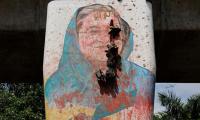The writer is a fellow of Asia Leadership Fellow Program, Tokyo, Japan.
T S Eliot in his poem ‘The Wasteland’ deals with the theme of memory and desire. Writing about spring, he declares April as “the cruellest month, breeding, Lilacs out of the dead land, mixing, Memory and desire, stirring, Dull roots with spring rain.”
This is a very pessimistic depiction of spring when traditionally it was seen as a time of rejuvenation of nature and life on earth. Eliot considers winter better because it lulls us to hibernation under its white sheet.
It was in spring, on March 11, 2011, that Japan experienced a disaster in the shape of a gigantic tsunami caused by a 9.0-magnitude earthquake resulting in the death of 16,146 people and destruction of 126,491 houses. Around 3,333 people were reported missing and 227,600 houses were said to have been partially destroyed. The great earthquake of Japan in spring 2011 left deep scares in the minds of the affected people by altering the physical landscape and creating imbalance in the psychological order.
Through concerted efforts, the Japanese government, and its social workers, communities and the civil society rehabilitated the physical infrastructure to great extent, but the mind has remained mired in grief because of the painful memories associated with loved ones and the physical place. In such a traumatic situation, the heavy burden of memories, nostalgia and grief cripples people’s capacity to see the colours of life and feel life around them.
To cope with traumatic experiences and memories, different stakeholders have introduced psychological initiatives for the rehabilitation of selfhood and community. Such initiatives are in line with the Japanese propensity to thinking anew to deal with a challenging situation. A salient feature of the initiatives undertaken to heal the traumatic mind is the rootedness of psychological understanding and practices in local cultural and social settings. This stems from the Japanese way of understanding that tends to appropriate, hybridise and contextualise the discipline of modern psychology.
Japan’s traditional practices of psychotherapy are rooted in Shinto and Buddhist traditions. After living in isolation for centuries, the country opened itself to modernisation after the Meiji revolution in 1868. This exposed people to the material and intellectual aspects of modernity. Interestingly, the Japanese adopted natural sciences and some disciplines of the social sciences in their entirety. However, in the humanities the case is different. For instance, instead of accepting the psychological postulates of modern psychology lock, stock and barrel, Japanese theoreticians and practitioners have merged indigenous insights and practices with modern psychology.
However, it would be fallacious to think of Japanese psychotherapy and psychiatric practices as a reflection of pure indigenous practices. In fact, the two major schools of therapy – Morita and Naikan – emerged in the twentieth century when their founders borrowed some elements from the Western psychoanalytic approach and adjusted them to the psychological systems of pre-modern period.
Morita psychotherapy was formalised by Professor Masatake Morita who was chairman of the Department of Psychiatry at the Jikei University School of Medicine in Tokyo. Yoshimoto Ishin founded the Naikan school of thought. He started the Naikan method in prison when he was working as its chaplain and later established an institute. Yoshimoto tried to create non-religious practices by decoupling Shin Buddhism from the Naikan therapy, while keeping these practices as a hybrid of religious and modern on the one hand, and dereligionising the conceptual vocabulary on the other.
The eclectic approach of Japanese psychiatric practices might not fit well into the disciplinary schema of modern psychology because – unlike the Western philosophical tradition of binary of mind and body – Japanese philosophy tries to harmonise discordant elements. That is why the psychiatric/therapeutic practices in Japan treat memory, healing and the body as part of the single whole. Any dissonance in these creates mental illness. To treat mental illness and trauma, the Japanese psychotherapies of Morita and Naikan expand their scope to include the lifeworld of the patient instead of solely focusing on the patient to search for traces of Oedipal and Electra complexes.
Like modern psychiatry, memory also holds a central position in Japanese psychiatry. Despite its differences in detail, Japanese psychiatry is close to existentialist psychology for it views individual memory in relation to a person’s lifeworld.
The Naikan method of treatment is unlike typical psychoanalysis wherein the atomised individual is explored to find the nebulous self shrouded in the mist of unconsciousness. Instead, it attempts to reconstruct the life history of the individual by including social memory. When a patient colours his whole self with individual memory, he expels external or social constituents of the self. This creates a lacuna. At such a moment, private memories rush in to capture the self, and thus create a dissonance within the individual. The psychotherapy techniques in Japan aim at rearranging memory that is affected by the mental quake in the self.
The eclectic and context-specific nature of Japanese psychiatry and psychoanalytic/therapy practices allow space for the people to devise techniques rooted in a highly local context. In the Otsuchi town of north-east Japan, a local resident, Itaru Sasaki, introduced a novel practice named ‘the phone of the wind’. Wind in Japanese mythology has an important place as one can feel the winds and its whispers. The Japan god of wind is F?jin. The town of Otsuchi was wiped out completely by the earthquake and tusnami.
‘The phone of the wind’ is situated in the beautiful Japanese garden of Sasaki from where people make a phone call to those they lost in the earthquake. Since there is no one present at the other end, the voice dissolves into the wind like a whisper. Kujira thinks that ‘Too much of grief deprives us of sensation. By making a phone call, the aggrieved person feels sensation. We can only turn our hell into heaven by employing the power of imagination, which is only bestowed upon human beings. [A] Telephone to heaven means turning our hell into heaven.’
In Japanese thought ‘ki’ (vital energy) is a crucial concept. Chikako Ozawa-de Silva in her book ‘Psychotherapy and Religion in Japan’ is of the view that “health and illness are understood [in Japan] as a matter of balancing the ki energy. Thus, mental illness are (sic) understood as an imbalance of ki.” She further writes, “Illness as disharmony is referred to in Japanese as yamai wa ki kara, or ‘illness from the mind (ki)”. Madness is kichigai which means ‘ki has changed’. Seen in this way, madness and mental illness is disharmony within the self, and between self and society and the world. Psychiatric practice is a leap of imagination to restore the senses and ideas, and their harmonious function in maintaining selfhood. It is an attempt to restore holistic personality who has lost zest and energy for life.
So it can be said that the psychological rehabilitation of a person from depression and madness is the restoration of the energy to feel. It is an attempt to awake the person who prefers to remain in hibernation in the winter because of the fear that memories will sprout forth in the warmth of the spring. These insights not only help us understand psychological practices in Japan, but also make us realise our own madness in Pakistan, which is evident in the imbalance of power between state institutions. Perhaps we are in dire need of psychotherapy to restore the balance in our imbalanced polity.
Email: azizalidad@gmail.com
Government is determined to unleash full power of Reformistan’s economy and pave way for unprecedented growth,...
We might begin, as Changchun-of-old did, by stating obvious: what is, does not work
Country is deeply divided, and this fragmentation cannot be addressed through symbolic actions or occasional...
SBP and SECP must urgently issue clear and concise regulations defining legal status of cryptocurrencies in Pakistan
Pakistan secure its sovereignty, fortify its defence, and rise above limitations imposed by punitive external measures
Old-fashioned ideas resist change and people prefer an unchanging social atmosphere over a cautious and prudent move...







